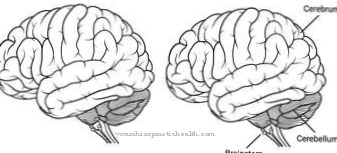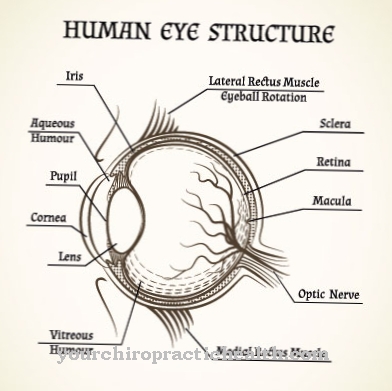The Guillain-Barré Syndrome is an acute inflammation of the peripheral nerves and spinal ganglia (nerve nodes in the vertebral canal) with an as yet unexplained etiology (cause). With a frequency of 1 to 2 new cases in 100,000 people per year, Guillain-Barré syndrome is a rare disease that affects men slightly more often than women.
What is Guillain-Barré Syndrome?

© sanjagrujic - stock.adobe.com
The Guillain-Barré syndrome is an acute idiopathic (unclear etiology) polyneuritis with multifocal (occurring in several locations) inflammation in the peripheral nervous system.
Inflammatory changes, especially in the roots of the peripheral nerves (polyradiculitis) and the proximal dorsal root ganglia, cause sensory disorders, motor paralysis and vegetative dysfunction. Particularly characteristic are paresthesias (tingling or "pins and needles") as well as paralysis rising from the legs, which in combination with respiratory paralysis and / or cardiac arrhythmias can be life-threatening.
In addition, involvement of the cranial nerves with swallowing and bilateral facial paralysis can be observed in some cases. Depending on the course, the Guillain-Barré syndrome is differentiated into different forms, the most common variant also being referred to as acute inflammatory (inflammatory) demyelinating (damaging the myelin sheath) polyneuropathy.
causes
The underlying causes of Guillain-Barré syndrome have not yet been conclusively clarified. Immunological processes in particular are suspected, since Guillain-Barré syndrome occurs in over half of those affected (around 60 to 70 percent) following pulmonary or gastrointestinal infectious diseases.
The Guillain-Barré syndrome is associated in particular with cytomegaly, varicella-zoster, measles, Epstein-Barr, mumps, hepatitis and HI viruses as well as certain bacteria such as Salmonella, Brucella, spirochetes, Mycoplasma pneumoniae or Campylobacter jejuni .
In very rare cases, Guillain-Barré syndrome manifests itself after influenza or rabies vaccinations. It is assumed that the antibodies formed by the body as a result of the infection are directed against the body's own structures, in particular against the gangliosides that are increasingly found in the nervous system, and, in combination with other as yet unknown factors, cause the development of Guillain-Barré syndrome.
You can find your medication here
➔ Medicines for muscle paralysisSymptoms, ailments & signs
The symptoms of Guillain-Barré syndrome are largely dependent on the form of the disease. A basic distinction is made between acute and chronic forms. In general, Guillain-Barré syndrome is characterized by an increasing general weakness due to the destruction of peripheral nerves and spinal nerve roots.
The acute form (acute inflammatory demyelinating polyneuropathy or AIDP) begins with back pain and limb pain, tingling and numbness in the fingers, toes, nose, ear or chin (acra) and paralysis in the legs. In addition, the muscles of the pelvic, torso and respiratory muscles weaken, causing all reflexes to fail. Sometimes certain cranial nerves also fail.
This leads to a disruption of breathing regulation, regulation of heart rate and bladder emptying as well as temperature regulation. Furthermore, circulatory disorders occur due to fluctuations in blood pressure.The chronic form of the Guillain-Barré syndrome, also known as chronic inflammatory demyelinating polyneuropathy (CIDP), begins insidiously and is characterized by alternating pronounced symptoms.
In chronic inflammatory demyelinating polyneuropathy, paralysis of the legs and paresthesia of the acra are in the foreground. The involvement of cranial nerves is observed less often. The paralysis increases much more slowly in the chronic form. They can even be suppressed by the administration of glucocorticoids. Overall, a third of the patients can be cured. Ten percent of the sick die. Some of those affected require lifelong care.
Diagnosis & course
Guillain-Barré syndrome is usually diagnosed using a CSF analysis (examination of the nerve water). If an increased protein concentration (cytoalbuminal dissociation) can be detected with a normal number of cells, Guillain-Barré syndrome can be assumed.
In addition, in Guillain-Barré syndrome, the nerve conduction velocity, which is measured in the context of electroneurography, is reduced. Electromyography enables statements to be made about possible disorders of the nerve tracts supplying the muscle fibers. However, this diagnostic method is not suitable for the early diagnosis of Guillain-Barré syndrome, as the corresponding changes can only be determined after about two weeks.
Any cardiac arrhythmias that are present can be determined with the help of an electrocardiogram, while the respiratory function can be checked with a lung function and blood gas analysis. In addition, antibodies against gangliosides are detectable in the serum in many cases. Guillain-Barré syndrome usually has a favorable course and those affected are largely or completely healed within 1 to 6 months.
Complications
With Guillain-Barré syndrome, those affected suffer from inflammation of the nerves. In most cases, this inflammation leads to disorders of sensitivity and paralysis. These do not have to occur all over the body; the affected region usually depends on the respective disturbed nerve. The patient suffers from the typical tingling sensations and numbness.
In addition, most patients experience back pain and pain in the muscles. There are also disorders of coordination and gait disorders. The patient's movement is restricted by Guillain-Barré syndrome. In the worst case, paraplegia occurs, with the patient then being dependent on a wheelchair.
It is not uncommon for other people to also need help in everyday life in order to continue to master it. The pain can also occur at night and lead to difficulty sleeping. In many cases, the patient's immune system is also weakened, making it easier for inflammations and infections to occur.
Guillain-Barré syndrome can be treated with medication. The earlier treatment occurs, the greater the likelihood that the patient will be completely cured. Late treatment can lead to consequential damage, which is usually irreversible and can no longer be treated.
When should you go to the doctor?
Guillain-Barré syndrome must always be evaluated by a doctor. Without treatment, it can lead to serious complaints and complications, most of which are irreversible. As a rule, the doctor should be consulted if there is severe back pain or paralysis that does not go away on its own.
Numbness or sensitivity disorders can also indicate Guillain-Barré syndrome. Those affected often suffer from a tingling sensation in the affected regions. Furthermore, the doctor should be consulted if there is severe pain in the muscles.
The pain can occur even without movement. Likewise, disturbances in coordination or gait disorders often point to the Guillain-Barré syndrome. If the syndrome is not treated, it can, in the worst case, lead to complete paraplegia. This is irreversible and can no longer be treated.
If these symptoms occur, a general practitioner should be consulted. This can determine the Guillain-Barré syndrome. Further treatment, however, depends on the exact symptoms and causes of the syndrome and is then treated by a respective specialist.
Doctors & therapists in your area
Treatment & Therapy
In Guillain-Barré syndrome, the therapeutic measures correlate with the specific course of the disease. In mild cases, the therapy aims to reduce existing paresis (paralysis of the muscles) and minimize the risk of infectious diseases, pneumonia, thrombosis and contractures (limited mobility of the joints) and decubitus (bed sores) through physiotherapeutic measures.
Occupational therapy measures (e.g. exercises with the hedgehog ball) are used to increase surface sensitivity. In the case of severe or acute disease progression with pronounced impairments such as walking, breathing and / or swallowing disorders, therapeutic intervention is made in the immune system of the person affected (immunotherapy). For this purpose, plasmapheresis or intravenously infused immunoglobulins are usually used.
In a plasmapheresis therapy, the body's own plasma is replaced by a substitution solution enriched with albumin in order to exchange the immunoglobulins or antibodies responsible for the neurological impairments. In the context of immunoadsorption, which is a newer therapeutic method, only the pathologically effective antibodies are removed from the plasma and substituted.
A gentler therapeutic measure are intravenously infused immunoglobulins, which neutralize the responsible endogenous as well as viral and bacterial antibodies and inhibit their synthesis. In addition, immunoglobulins reduce the activity of certain cells of the immune system, the so-called macrophages.
In many cases, the affected person needs to be intubated or ventilated, which can result in respiratory therapy measures. If the Guillain-Barré syndrome is life-threatening, a temporary pacemaker may be necessary if bradycardia (slow heartbeat) is present.
Outlook & forecast
Guillain-Barré syndrome cannot be completely cured because it is a genetic disorder. Therefore only symptomatic treatment can be given, which can limit and reduce the symptoms.
In most cases, those affected very often develop inflammation of the lungs, thromboses and other infectious diseases as a result of the syndrome, so that the life expectancy of the patients is often reduced. This can also lead to breathing disorders or swallowing disorders, so that the patient is dependent on the help of other people throughout his life.
The immune system can be strengthened by injections or by taking medication, although lifelong therapy is also necessary. Many sufferers also rely on a pacemaker to extend life expectancy. In some cases, the patient's everyday life can be made easier with the help of physiotherapeutic exercises.
The Guillain-Barré syndrome often leads to depression or other psychological disorders, so that most patients are dependent on psychological treatment. If Guillain-Barré syndrome is not treated, the patient's life expectancy is drastically reduced and there are significant restrictions in everyday life.
You can find your medication here
➔ Medicines for muscle paralysisprevention
Since the etiology of Guillain-Barré syndrome is not clear, there are no preventive measures for this disease.
Aftercare
Since Guillain-Barré syndrome is a hereditary disease, the options for follow-up care are very limited. Therefore, the early detection and treatment of this disease is in the foreground. If a person with Guillain-Barré syndrome wishes to have children, genetic counseling can also be carried out so that the syndrome is not passed on.
This syndrome may also limit and reduce the life expectancy of the patient. The treatment of the syndrome always depends on the exact severity and type of complaint. As a rule, the patient is dependent on physiotherapy measures, with many exercises from this therapy also being carried out at home.
This usually speeds up healing. The patient's body must also be protected from various infections and other diseases in order not to unnecessarily burden the immune system. Since the internal organs and the heart are also affected by Guillain-Barré syndrome, regular examinations should be carried out in order to detect damage at an early stage.
Surgical interventions on the heart may also be necessary. In many cases, contact with other patients with Guillain-Barré syndrome can also be useful, as this leads to an exchange of information.
You can do that yourself
The aim of all self-help measures is to enable those affected to achieve the greatest possible independence in everyday life. Outpatient physical and occupational therapy is indicated to prevent loss of mobility. Medical training therapy (MTT) is particularly suitable here.
As part of this training, a training plan is developed that is adapted to the patient's performance. After a few accompanied therapy units, those affected can perform these exercises independently. This can be done in special training centers as well as in the home using exercise bikes or gymnastics.
Occupational therapy treatment is useful in relation to the sensitivity disorders of the upper and lower extremities. Functional disorders of the extremities are also improved as part of this therapy through exercises that can also be adapted to everyday life according to instructions. Irrespective of the medical training therapy, water aerobics is recommended.
The buoyancy in the water makes it particularly muscle-strengthening. In addition, gait training can be carried out for everyday activities. Changing surfaces, climbing stairs and varying the speed train the sense of balance and the sensitivity of the feet.
Advice on home care as well as advice on aids is indicated in the event of severe progress. The sudden loss of skills leads to reactive depression for many people. Psychological support in coping with illness or self-help groups increase the understanding of the illness and help with adaptation to everyday life.



.jpg)









.jpg)

.jpg)
.jpg)











.jpg)